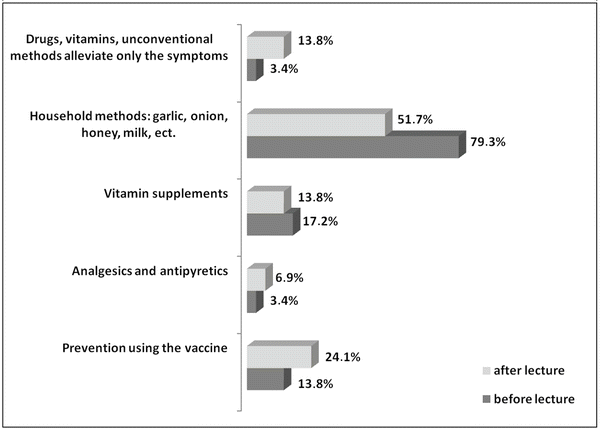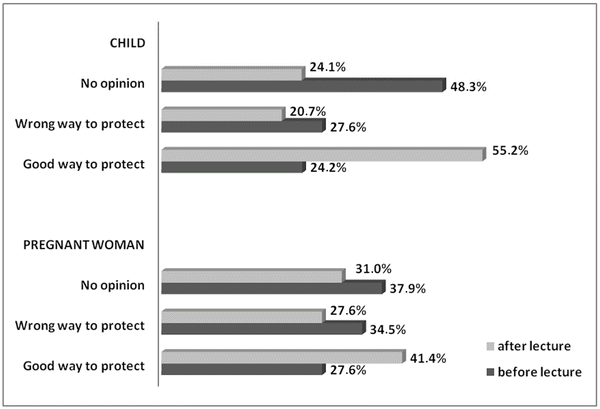Before lecture
After lecture
% of answers
% answers
Information given by the mass media on vaccination against influenza is:
Sufficiently communicated
24.1
51.7
Insufficiently communicated
55.2
41.4
No opinion
10.3
3.4
No answer
10.3
3.4
Sources of information on vaccination against influenza:
Mass media
31.0
48.3
Scientific publications via Internet
37.9
27.6
Family
6.9
10.3
Medical staff
37.9
24.1
Others
10.3
10.3
Influenza complications:
Known
93.1
93.1
Unknown
6.9
6.9
Optimal timing of vaccination against influenza:
Beginning of autumn
69.0
69.0
Winter
0
3.4
Spring
0
0
It does not matter
6.9
10.3
I do not know
24.1
17.2
Influenza vaccine component content:
Whole virion
6.9
10.3
Glycoproteins: hemagglutinin and neuraminidase
6.9
17.2
RNA of the virus
13.8
37.9
I do not know
72.4
34.5
Number of people who die worldwide each year from influenza and its complications:
10,000 cases
6.9
0
100,000 cases
13.8
6.9
1,000,000 cases
6.9
51.7
I do not know
72.4
41.4
The results demonstrate the effectiveness of disseminating professional medical information on seniors’ attitude toward the influenza issue. Respondents indicated the mass media and scientific publications available via the Internet, followed by medical personnel, as the most notable sources of information about influenza and vaccination. The mean rating of the knowledge on vaccination and influenza vaccine was also high. The comprehensive understanding of medical issues linked to influenza clearly increased after the lecture presentation as the positive response to the item ‘Sufficiently communicated by the media’ more than doubled; from 24.1 % before to 51.7 % after the lecture (Table 1). The lecture presentation enhanced the knowledge of the elderly listeners on the composition of the vaccine, its most components, health complications of influenza, including possible fatality, and when and who to vaccinate.
The second thematic block concerned the opinion of the elderly on influenza and influenza vaccination. Respondents were asked about the best ways to prevent the flu, the merit of vaccination in pregnant women and in children over 6 months of age. The percentage distribution of responses to the surveys is shown in Figs. 1 and 2.



Fig. 1
Methods of protecting against influenza in elderly’s opinion

Fig. 2
Elderly’s opinions regarding influenza vaccination in young children and pregnant women
The analysis demonstrates that the lecture presentation, among others, positively shifted the elderly’s frame of mind on the protective value of influenza vaccine, as more than 10 % of participants changed their attitude toward vaccination, marking that vaccination is the best preventive method (Fig. 1). However, the long-lived untoward habits made the elderly choose household remedies as the most popular method of protection against influenza infection; although also in this case the percentage of people who selected this method significantly decreased after the lecture. It is likely that the persisting attitude toward household protective methods reflects the view and knowledge of the elderly at large, a sector of the society that particularly shuns flue vaccination despite being clearly vulnerable to infection.
Stay updated, free articles. Join our Telegram channel

Full access? Get Clinical Tree


